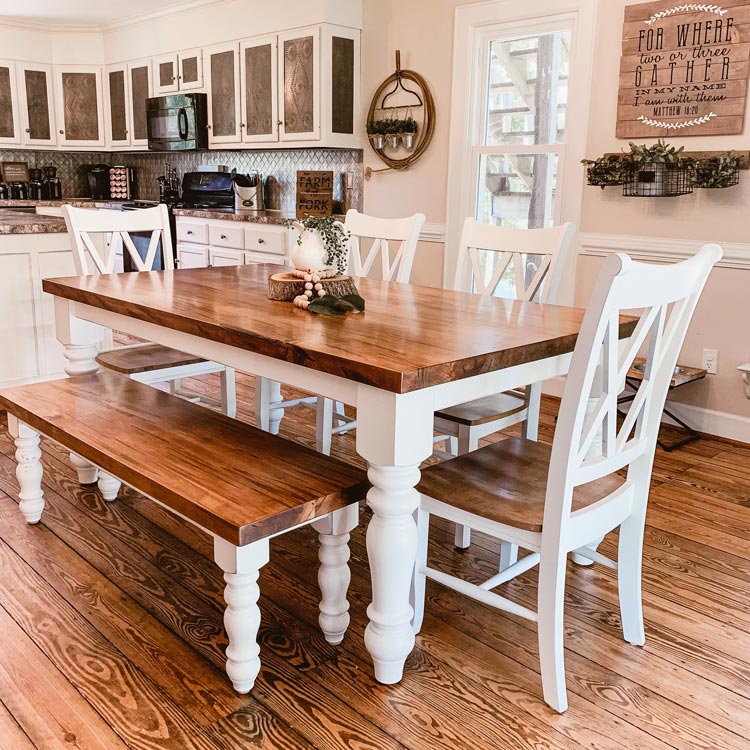Transform Your Dining Space with Stylish Dining Room Table Legs
Transform Your Dining Space with Stylish Dining Room Table Legs
Blog Article
Specialist Tips for Putting Up Eating Space Table Legs for Maximum Stability
When it comes to mounting dining area table legs, achieving maximum security is vital for both performance and visual appeals. What details techniques can improve security even better?
Choose the Right Legs
When picking the suitable legs for your dining area table, it is vital to consider both performance and aesthetics. The legs you select will substantially impact the overall style and stability of the table. Evaluate the table's intended use; if you expect frequent gatherings, sturdier legs, such as those made from solid wood or steel, might be more suitable, as they offer increased resilience and support.
Next, think about the elevation and style of the legs in connection with the tabletop. Conventional table normally range from 28 to 30 inches in height, so guarantee the legs align with this standard for convenience. The design of the legs must match the design of the tabletop-- whether it be modern-day, rustic, or typical. For example, tapered legs can add a modern touch, while transformed legs may communicate a more timeless visual.

Select Appropriate Equipment
How can the ideal hardware enhance the security and durability of your eating room table? The choice of ideal hardware is important to guaranteeing that the legs of your table are firmly attached and able to withstand routine use. High-grade screws, screws, and braces provide the needed toughness to support the weight of the table, in addition to any type of added lots placed upon it during celebrations or meals.
When choosing screws, choose for those made from sturdy products such as stainless steel or brass, which resist rust and preserve stability with time. The size of the screws is equally important; they ought to permeate deeply right into the table's framework without endangering integrity. For bolted connections, consider using lock washers to avoid loosening because of vibration or motion.
In addition, making use of edge braces can add extra assistance, particularly for larger tables or those with heavier tops. These braces disperse weight uniformly and help keep the table's shape. Making certain that the hardware you choose is proper for the particular materials of your table will certainly even more enhance its total stability and durability, enabling you to appreciate your dining experience for many years to come.
Ensure Proper Placement
Proper positioning of eating area table legs is crucial for both visual appeal and useful security. Misaligned legs can result in an uneven tabletop, which may not just be visually uninviting however also endanger the table's usability. To accomplish optimal placement, begin by determining the distance from the table's edges to the leg attachment factors. This ensures that each leg is located equidistant from the sides, producing a well balanced look.
Utilize a level during installation to validate that each leg is perpendicular to the helpful site tabletop. It is recommended to mark the preferred leg settings on the bottom of the table with a pencil or concealing tape prior to protecting them.
In addition, double-check the alignment after the initial screws are tightened, as adjustments may be necessary before totally securing the equipment. By focusing on correct placement, you not just boost the table's total design yet additionally guarantee that it remains practical and steady for many years to find.

Consider Weight Circulation
After making sure appropriate alignment of the dining area table legs, it is very important to think about weight distribution to enhance security and performance. dining room table legs. Proper weight distribution is crucial in stopping making certain and wobbling that the table can sustain its designated load without danger of tipping or collapsing
When placing the legs, guarantee they are put at equal ranges from the center of the table to uniformly distribute the weight throughout the structure. Take into consideration the weight of the table top and any things that will frequently relax on it, such as ornamental items or tabletop home appliances. Tables with heavier surface areas should preferably have legs positioned closer to the corners, as this optimizes the base of support and decreases the risk of instability.
In addition, if the table is intended for use in a high-traffic location, consider utilizing larger products additional info for the legs or adding supporting components, such as cross-bracing or a lower shelf - dining room table legs. These changes can assist keep balance and protect against shifting during usage. Ultimately, a well-considered weight circulation method will considerably enhance the table's general efficiency, ensuring it continues to be a attractive and functional centerpiece for your eating space
Test Stability Prior To Use
Testing the security of the eating space table before use is an important step that ought to not be neglected. If the table shows instability, recognize the legs or joints that might need adjustment.
Following, examine that all fasteners and screws are tightened up effectively. Loose connections can lead to instability and possible damage in time. If necessary, make use of timber glue on joints to boost security, guaranteeing to allow ample drying time.

Final Thought
In verdict, the installation of dining area table legs requires cautious factor to consider of products, equipment, weight, and placement distribution to achieve maximum security. By picking sturdy legs and top notch bolts, ensuring accurate positioning, and dispersing weight equally, the architectural honesty of the table can be significantly improved. Carrying out a security examination before regular use further guarantees that the table will certainly hold up against day-to-day stress, thereby providing a reputable and risk-free dining experience.
When it comes to installing dining room table legs, achieving maximum stability is paramount for both functionality and aesthetic appeals. The legs you select will substantially affect the general design and stability of the table (dining room table legs). Basic dining tables typically vary from 28 to 30 inches in elevation, so make sure the legs align with this standard for convenience.Correct positioning of dining room see here now table legs is essential for both visual allure and practical stability.In conclusion, the installment of eating space table legs requires careful factor to consider of products, weight, equipment, and positioning distribution to achieve optimum stability
Report this page